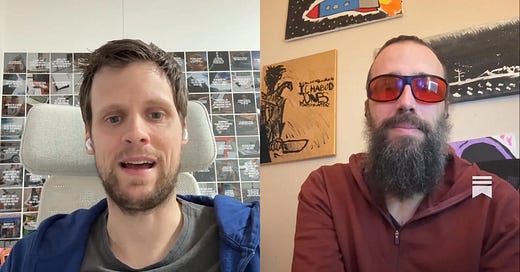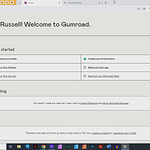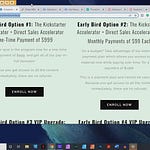The growing popularity of Substack has created fresh opportunities for writers to reach new audiences, deepen relationships with existing fans, and share knowledge with minimal barriers to entry. At the same time, simply starting a Substack isn’t enough to guarantee sustainable success—especially if you want it to become part of a meaningful creative career rather than just a hobby. You’ll quickly realize the importance of having a clear purpose, finding (and occasionally redefining) your niche, and knowing how to adapt when opportunities arise or when life throws you curveballs.
In a recent conversation, one well-known creator (author of “How to Build a World-Class Substack”) shared insights that go beyond routine newsletter tips. He discussed balancing joy with monetization, exploring multiple areas of expertise, and staying open to the possibility of “pivoting” your brand or business whenever data suggests it’s time. While the conversation touched on Substack specifically, these lessons apply broadly to writing, business-building, and entrepreneurship as a whole. Below, we break down the main lessons so you can apply them to your own creative journey.
Putting “Money as Means” Instead of Money as an End
One of the first big ideas is the importance of reframing your relationship with money. While some business gurus treat revenue as the primary end goal, many creators are uncomfortable with the idea of “selling, selling, selling.” For them, money is the means to keep creating. It pays for the resources, covers basic living expenses, and, ideally, sustains them so they can focus on their craft.
If this resonates with you, then you may find it helpful to reorient your mindset:
Create for Impact, Not Just Profit
Yes, you should charge for your best material—especially if you want your creative pursuits to be more than a hobby. But do so from the standpoint that money fuels a bigger vision. For instance, a writer might monetize a Substack subscription so they can afford to spend more time researching and writing meaningful content.Give Away Some Content Freely
Paradoxically, offering certain things for free can help you grow faster. Free samples, giveaways, or zero-cost tiers on Substack remove friction for potential readers or buyers. They let people test your value proposition with no risk, and often convert more effectively into paying fans. You’re optimizing for growth in these moments, not immediate profit.
Finding the Right Niche (Eventually)
“Niche” is one of the most talked-about words in modern content marketing. Many experts suggest narrowing down your audience so you can become the go-to authority for that specific topic. However, the transcript underscores a valuable nuance: you might not know your ultimate niche right away. In fact, there’s value in exploring different formats, genres, and specializations early on.
Experiment Broadly at First
Early in your career, try your hand at multiple types of writing or diverse topics, whether it’s romantic comedy screenplays, non-fiction guides, or daily motivational posts. The broader your experimentation, the clearer the data you’ll gather about where your true passion and audience overlap.Let Data (and Joy) Guide You
Keep an eye on what resonates with readers. Over time, a certain theme, angle, or style may consistently generate more enthusiasm—and you might enjoy writing it more, too. This combination of personal excitement and audience engagement is an ideal sweet spot. That is typically where you start narrowing down and doubling up on your efforts.
Why Homogeneity Kills Small Publications
On paper, it might seem logical to stick to one hyper-focused topic, aiming to please every single reader, every time. Yet doing so can lead to “homogeneity”—where every post is essentially the same. When that happens, both you and your audience risk boredom, and newcomers may not see much reason to stick around.
Instead, aim to speak to segments within your audience. Even if you primarily address one niche—say, personal finance or creativity—your readers have different tastes and experiences. Write posts that appeal strongly to smaller groups on a rotating basis. As long as each group feels catered to at some point, they remain engaged and share your work with like-minded people.
Example: Tim Ferriss once remarked that each podcast episode might only appeal to around 25% of his audience. Yet by ensuring each segment is addressed regularly, the overall show remains fresh and relevant. Likewise, your Substack might run an interview series for one subset, personal opinion essays for another, and in-depth research pieces for a third.
The Art of the Pivot
Pivoting is essentially changing direction in your creative or business journey—sometimes by choosing a new primary platform, exploring an adjacent industry, or even switching from one product type to another. For many creators, pivoting can feel risky or disloyal to your initial audience. However, the transcript conversation highlighted two key ideas that enable graceful, productive pivots:
Don’t Abandon Your Core Theme
You can remain consistent in your overall mission or “why” while changing the outward form of your work. For example, an author who loves empowering people’s creativity can shift from writing primarily about Substack to writing about Kickstarter or direct sales, because it’s still about helping aspiring creators succeed. Your audience will see the continuity if you communicate that deeper purpose.Leverage Existing Skills
Pivoting becomes far easier if you have a range of skills and experiences. If you’ve ever done public speaking, built an online course, or run a blog in another industry, you can transfer that expertise to new platforms. Stay curious and open-minded: sometimes the best tool for your next pivot comes from a totally different field.
Striving for Authenticity (and Keeping Ego in Check)
It’s tempting to measure your worth by the number of subscribers, the amount of monthly revenue, or the size of your social-media following. Yet the conversation reminds us how dangerous that can be. Life is unpredictable, and business numbers can rise or fall for reasons beyond your control. If you find your self-worth heavily tied to a certain metric, a future dip could do real damage to your mental health and motivation.
Practical Tip: If you notice yourself feeling down or anxious when you see someone else “going viral,” practice stepping away from the comparison. Remind yourself that each creator has a different timeline, starting point, and personal context. Meditation or journaling can help you regroup and refocus on what you can control: your own craft, message, and personal well-being.
Quarter-by-Quarter Learning
One particularly actionable strategy mentioned is to focus on one key area of learning or improvement each quarter. Devote a handful of days to immerse yourself in a topic—whether it’s advanced email automation, growing a membership site, or mastering a new design tool. Test ideas for a few months to see if they enhance your workflow and whether they resonate with your audience. This timeframe is long enough to see real results, yet short enough to let you pivot or change directions if it’s not working out.
The result, over time, is a collection of new skills that function like table legs: each skill provides support, so your entire business doesn’t collapse if one income stream weakens. This approach fosters stability and keeps you excited about learning, preventing creative stagnation.
Practical Takeaways for Your Substack Journey
Start Broad, Then Narrow
At the outset, experiment with varied content. Track which types of posts generate the most positive feedback and personal enthusiasm. Over time, you’ll discover a sweet spot.Don’t be Afraid to Give Away Value
If your goal is audience growth, removing friction is key. Provide substantial free posts or previews. Once readers trust you, they’ll be more receptive to paid offers.Be Open to Collaboration
Cross-promotion, interviews, and co-created content can break up the monotony, reach fresh audiences, and shine a light on perspectives you may not personally cover. This variety also helps you avoid homogeneity in your newsletter.Pivoting Is About Expanding Your Mission
Adapting doesn’t mean discarding your old identity. Instead, find new ways to apply your central theme to different formats, platforms, or specific niches.Detach Self-Worth from Metrics
Financial or follower-based success is often fleeting. It’s okay to celebrate big wins, but remember to remain grounded in the intrinsic worth you had before any accolades.
Conclusion
Building a world-class Substack (or any creative enterprise) is about more than just “writing good posts.” Yes, consistent, high-quality writing is foundational. But the difference between short-term hype and long-term sustainability lies in how you think about growth, collaboration, monetization, and pivoting. Ask yourself what truly drives your work—money as the means to a greater mission? Growth for the sake of helping more people? Or maybe the sheer joy of exploration and creativity?
When those bigger “why” questions are answered, you’ll find Substack and other platforms are simply the channels through which you bring your ideas to life. Keeping your eyes open to new opportunities, staying flexible, and building skill upon skill each quarter can gradually turn your one-person writing venture into a multi-faceted, resilient business—one that can pivot and thrive, no matter what changes the future brings.

















Share this post